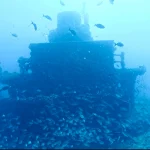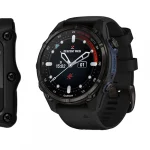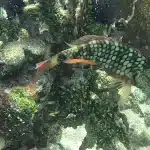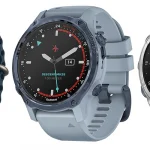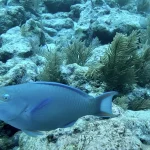Table of Contents
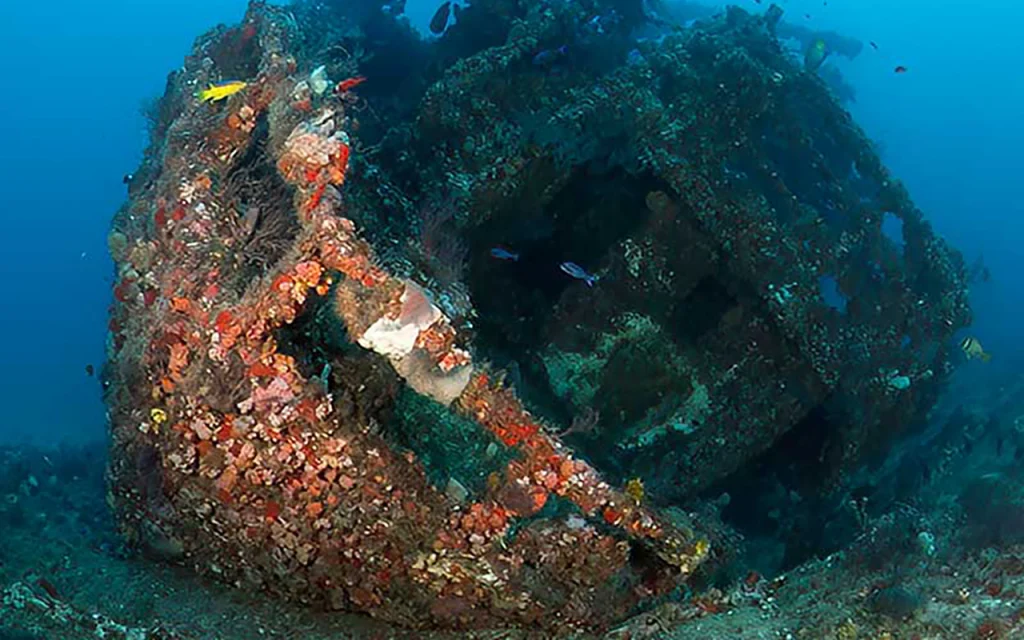
The MV Castor’s transformation from a cargo ship to a vibrant artificial reef exemplifies the intersection of maritime history and ecological conservation, making it a significant site for divers and marine enthusiasts alike.
Article at a Glance
- Location: Off the coast of Boynton Beach, Florida (26.1750° N, 80.0590° W)
- Depth: 80-110 feet, with the main deck at about 90 feet
- History: Built in 1970, seized in 1999 for drug smuggling, sunk as an artificial reef in 2001
- Size: 258 feet long, 37 feet wide, 50 feet tall
- Marine Life: Famous for large Goliath Grouper aggregations, especially during spawning season (July-October)
- Dive Experience: Advanced certification required due to depth and potential strong currents
- Unique Features: Colorful corals and sponges, collapsed midsection, tilted stern section
The MV Castor Wreck Location Coordinates and Depth
Depth
In terms of depth, the wreck sits at a range of 80 to 110 feet (approximately 24 to 34 meters), with the main deck at about 90 feet (27 meters) and the maximum depth reaching 110 feet (34 meters) where the wreck is upright and the bow points south.
Location Coordinates
The MV Castor wreck is located off the coast of Boynton Beach, Florida. The coordinates for the wreck are approximately 26.1750° N latitude and 80.0590° W longitude.
What to Scuba Divers Say About This Wreck
- Diverse Marine Life: The MV Castor is renowned for its seasonal aggregation of Goliath Groupers, which can weigh between 300 and 600 pounds. These fish are often seen resting on the wreck, particularly during the spawning season from August to October. Divers appreciate the opportunity to encounter these gentle giants up close, making it a popular dive site for photographers and enthusiasts alike.
- Wreck Condition: Since its sinking in December 2001, the wreck has experienced significant structural changes. The midsection has collapsed, and the aft wheelhouse is tilted at an angle, creating an interesting underwater landscape. The wreck is heavily colonized by vibrant corals and sponges, which adds to its visual appeal.
- Diving Experience: The wreck lies at a depth of 80 to 110 feet, with the main deck at about 90 feet. Due to strong currents, it is recommended that divers have advanced certification. The wreck is accessible for penetration dives, as all hatches and doors have been removed for safety.
- Scenic and Ecological Importance: The MV Castor serves as an artificial reef, contributing to the local ecosystem. Divers often report a rich variety of marine life, including schools of smaller fish that gather around the Goliath Groupers during spawning events. This dynamic creates a lively underwater scene that divers find captivating.
What Kind of Marine Life Can Be Found on The Wreck
- Goliath Groupers: The wreck is famous for its large population of Goliath Groupers, especially during their spawning season from late July to October. During this time, the number of Goliath Groupers can exceed 100, making it one of the largest aggregations in Florida. These massive fish often rest on the wreck, providing divers with an unforgettable experience.
- Schools of Scad: Small bait fish known as Scad are commonly found around the wreck, often in large schools. They come to feed on the eggs released by the Goliath Groupers during spawning, creating a dynamic feeding environment that attracts larger predators.
- Predatory Fish: The presence of Scad attracts larger fish such as Jacks and Barracuda, which are also frequently spotted by divers. These predatory fish add excitement to the dive as they hunt in the vicinity of the wreck.
- Colorful Corals and Sponges: The MV Castor is adorned with orange cup corals and various sponges, contributing to its reputation as one of the most colorful wrecks on the Palm Beach Coast. These organisms provide habitat and food for smaller marine species.
- Other Marine Life: Divers may also encounter a variety of other fish species, invertebrates, and marine flora that thrive in the artificial reef environment created by the wreck.
Key Information
| Aspect | Details |
|---|---|
| Wreck Name | MV Castor |
| Location | Off Palm Beach Coast, Florida |
| Coordinates | 26°10.500’N, 80°03.540’W |
| Depth | 80-110 feet (24-34 meters) |
| Length | 258 feet (79 meters) |
| Width | 37 feet (11 meters) |
| Height | 50 feet (15 meters) |
| Sinking Date | December 14, 2001 |
| Original Purpose | Dry cargo carrier |
| Current Status | Artificial reef |
| Notable Marine Life | Goliath Groupers, especially during spawning season (August-October) |
| Dive Difficulty | Advanced due to depth and potential currents |
| Best Visibility | Winter months |
| Unique Features | Colorful corals and sponges, collapsed midsection, tilted stern |
| Historical Note | Seized in 1999 for carrying 10,127 pounds of cocaine |
What Makes The MV Castor a Unique Diving Experience
- Goliath Grouper Aggregation: The wreck is famous for hosting one of the largest populations of Goliath Groupers along the Florida coast. During the spawning season from late July to October, divers can witness these massive fish, weighing between 300 and 600 pounds, gathering in numbers that can exceed 100. This phenomenon attracts divers from around the world, eager to see these gentle giants in their natural habitat.
- Diverse Marine Ecosystem: The wreck is adorned with vibrant orange cup corals and sponges, creating a colorful underwater landscape. This rich biodiversity supports a variety of marine life, including schools of smaller fish like Scad, which come to feed on the eggs released by the Goliath Groupers during spawning. Predatory fish such as Jacks and Barracuda are also commonly seen, adding to the dynamic underwater environment.
- Structural Changes: Since its sinking in 2001, the MV Castor has undergone significant structural changes due to natural wear and hurricanes. The aft wheelhouse is tilted, and the midsection has collapsed, creating interesting dive opportunities for exploration. The wreck’s layout is constantly evolving, ensuring that no two dives are ever the same, which keeps divers returning for new experiences.
- Challenging Conditions: The dive site is located in an area with varying currents, which can range from mild to strong. This unpredictability adds an element of excitement and challenge for divers, making it suitable for those with advanced certifications. The requirement for experience in strong currents enhances the thrill of the dive, appealing to more seasoned divers.
- Artificial Reef Contribution: As an artificial reef, the MV Castor plays a crucial role in supporting marine life and enhancing biodiversity in the region. This ecological significance, combined with its historical background as a former freighter, adds depth to the diving experience, allowing divers to connect with both nature and history.
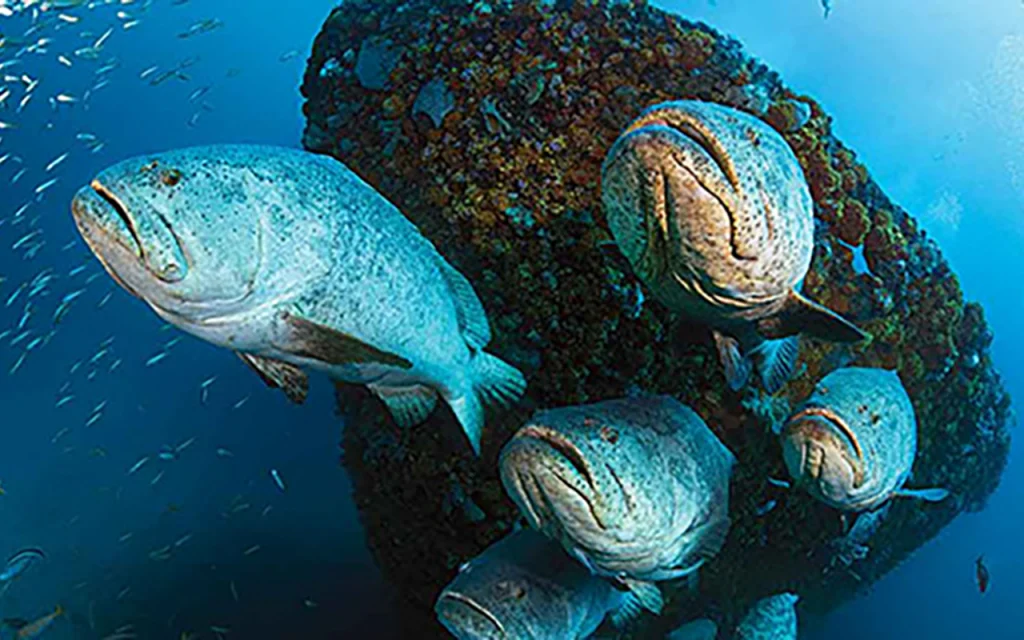
What is The Full History of This Wreck
Construction and Early Years
- Built in 1970: The MV Castor was constructed at the Bodewes Shipyard in Martenshoek, Netherlands. Originally named the M/V Dorothee Bos, it was designed as a dry cargo carrier for transporting timber and other goods.
Changes in Ownership and Use
- Renaming and Operations: In 1988, the ship was renamed the M/V Mer Star and began operating in the Caribbean waters, primarily transporting cargo between Spain and Mobile, Alabama. Over the years, it changed hands multiple times, reflecting its varied operational history.
Legal Troubles
- Seizure by U.S. Authorities: In 1999, the MV Castor was seized by U.S. Customs after being intercepted by the Coast Guard. The vessel was found carrying 10,127 pounds of cocaine hidden in bags of brown sugar. This incident led to legal actions against the crew, who were arrested.
Transition to Artificial Reef
- Sinking as an Artificial Reef: After the legal proceedings, the fate of the vessel was decided in favor of sinking it to create an artificial reef. On December 14, 2001, the MV Castor was intentionally sunk off the coast of Boynton Beach, Florida, as part of Palm Beach County’s Artificial Reef Program. The sinking aimed to enhance marine biodiversity and provide a habitat for fish, benefiting both the ecosystem and local fishing communities.
Current Status
- Wreck Characteristics: The MV Castor measures 258 feet long, 37 feet wide, and 50 feet tall, with its main deck at about 90 feet and the maximum depth at 110 feet. Over the years, the wreck has been affected by hurricanes, leading to structural changes, including the collapse of its midsection and the tilting of the stern. This has created an interesting underwater landscape that divers enjoy exploring.
- Marine Life: The wreck has become a thriving habitat for various marine species, particularly Goliath Groupers, which gather in large numbers during their spawning season from late July to October. The presence of these fish, along with other marine life, makes the MV Castor a popular dive site.
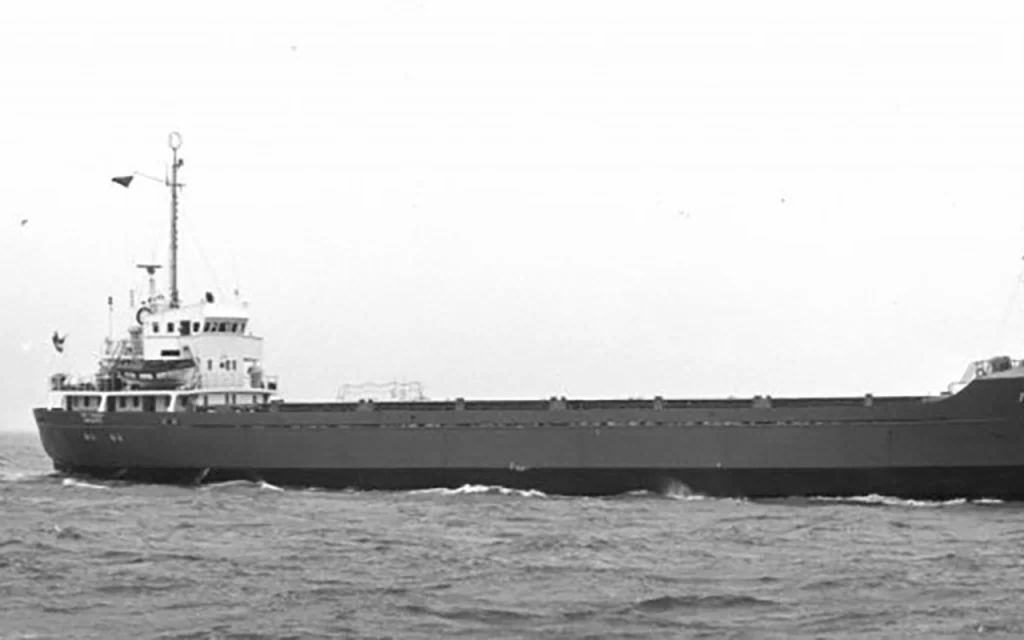
What Historical Features Can Still Be Identified on Wreck
Structural Remnants
- Size and Layout: The MV Castor measures 258 feet long and 37 feet wide, with a height of 50 feet. The wreck is oriented with the bow pointing south, and the main deck sits at a depth of about 90-100 feet, while the bow rises to about 80 feet.
- Stern Section: The stern of the ship, which contains most of the house structure, has rolled onto its starboard side due to the effects of hurricanes over the years. This area is particularly colorful, adorned with orange cup corals and sponges, making it visually striking and a focal point for divers.
- Midsection Collapse: The midsection of the wreck has collapsed, creating an interesting underwater landscape that divers can explore. This structural change adds to the wreck’s allure, as it provides various nooks and crannies for marine life.
Historical Significance
- Original Purpose: Built in 1970 as the M/V Dorothee Bos, the ship was designed as a dry cargo carrier for transporting goods. Its history includes various names and operational routes, primarily in the Caribbean.
- Seizure and Sinking: The wreck’s history took a dramatic turn in 1999 when it was seized by U.S. Customs while carrying 10,127 pounds of cocaine hidden in bags of sugar. After legal proceedings, the vessel was sunk on December 14, 2001, as part of Palm Beach County’s Artificial Reef Program.
Marine Life Interaction
- Goliath Groupers: The wreck is known for its seasonal aggregation of Goliath Groupers, particularly during their spawning season from late July to October. This interaction between the wreck and the marine life adds another layer of historical context, as the ship now serves as a habitat for these protected species.
- Ecological Role: As an artificial reef, the MV Castor has become a crucial part of the local marine ecosystem, supporting a diverse array of marine life, including schools of smaller fish that feed on the eggs released by the Goliath Groupers.
What Safety Measures Are in Place for Divers Visiting The MV Castor
Certification Requirements
- Advanced Certification: Divers are required to have at least an Advanced Open Water certification due to the depth of the wreck, which ranges from 80 to 110 feet. This level of certification ensures that divers are trained to handle the conditions they may encounter.
- Specialty Training Recommended: Additional certifications, such as Deep Diver Specialty and Wreck Diver Specialty, are recommended. Experience in strong currents is also advised, as the site can have unpredictable conditions.
Pre-Dive Briefing
- Conditions Assessment: Before diving, the divemaster provides a briefing about the current conditions, including visibility, water temperature, and current strength. This information is crucial for planning the dive safely.
- Dive Plan: Divers are briefed on the dive plan, including entry and exit points, as well as any specific areas of interest on the wreck.
Safety Equipment
- Wreck Line and Dive Flag: A wreck line is typically deployed to assist divers in descending and ascending safely. Divers are advised to hold onto this line throughout their dive to manage the current effectively.
- Signaling Devices: Divers are encouraged to carry signaling devices, such as safety sausages and whistles, to enhance visibility and communication with the dive boat.
Structural Safety Features
- Open Access: For safety reasons, all hatches and doors on the wreck have been removed, allowing for easy penetration and reducing the risk of entrapment.
- Visibility and Navigation: The wreck’s layout and the removal of barriers help divers navigate the site more easily, contributing to overall safety during exploration.
Emergency Preparedness
- Dive Crew Support: The dive crew is trained to handle emergencies and is equipped with first aid supplies and emergency oxygen. They monitor divers throughout the dive to ensure safety.
- Surface Support: The dive boat remains on standby, ready to assist divers in case of any issues, ensuring a quick response if needed.
Dive Shops That Prove Diving Trips to This Shipwreck
- Force-E Scuba Centers
- Location: Boca Raton, FL
- Rating: 4.9
- Details: They provide boat dives to the MV Castor and have multiple locations in South Florida.
- Website: Force-E Scuba Centers
- Aquatic Ventures
- Location: Fort Lauderdale, FL
- Rating: 5
- Details: Offers dives to the MV Castor, with trips departing from Pompano Beach.
- Website: Aquatic Ventures
- South Florida Diving Headquarters
- Location: Boynton Beach, FL
- Details: They organize dives to the MV Castor and provide information on dive conditions and marine life.
- Website: South Florida Diving Headquarters
South Florida Wrecks
- SS Copenhagen
- Captain Dan Wreck
- SS Arratoon
- Queen of Nassau
- USS Mohawk
- MV Castor
- Esso Bonaire III
- St. Jacques
- The Gilbert Sea
- Shasha Boekanier
- Thozina
- The Orion
- The DEMA Trader
- Ancient Mariner
- The Amaryllis
- The Ande
- USS Hydro Atlantic
- Zion Train
- Mercedes I
- Half Moon
- The Danny
- The Ultra Freeze
- The Doc DeMilly
- Jay Scutti
- The Tracy
- Sea Emperor
- Jim Atria
- Merci Jesus
- Princess Britney

